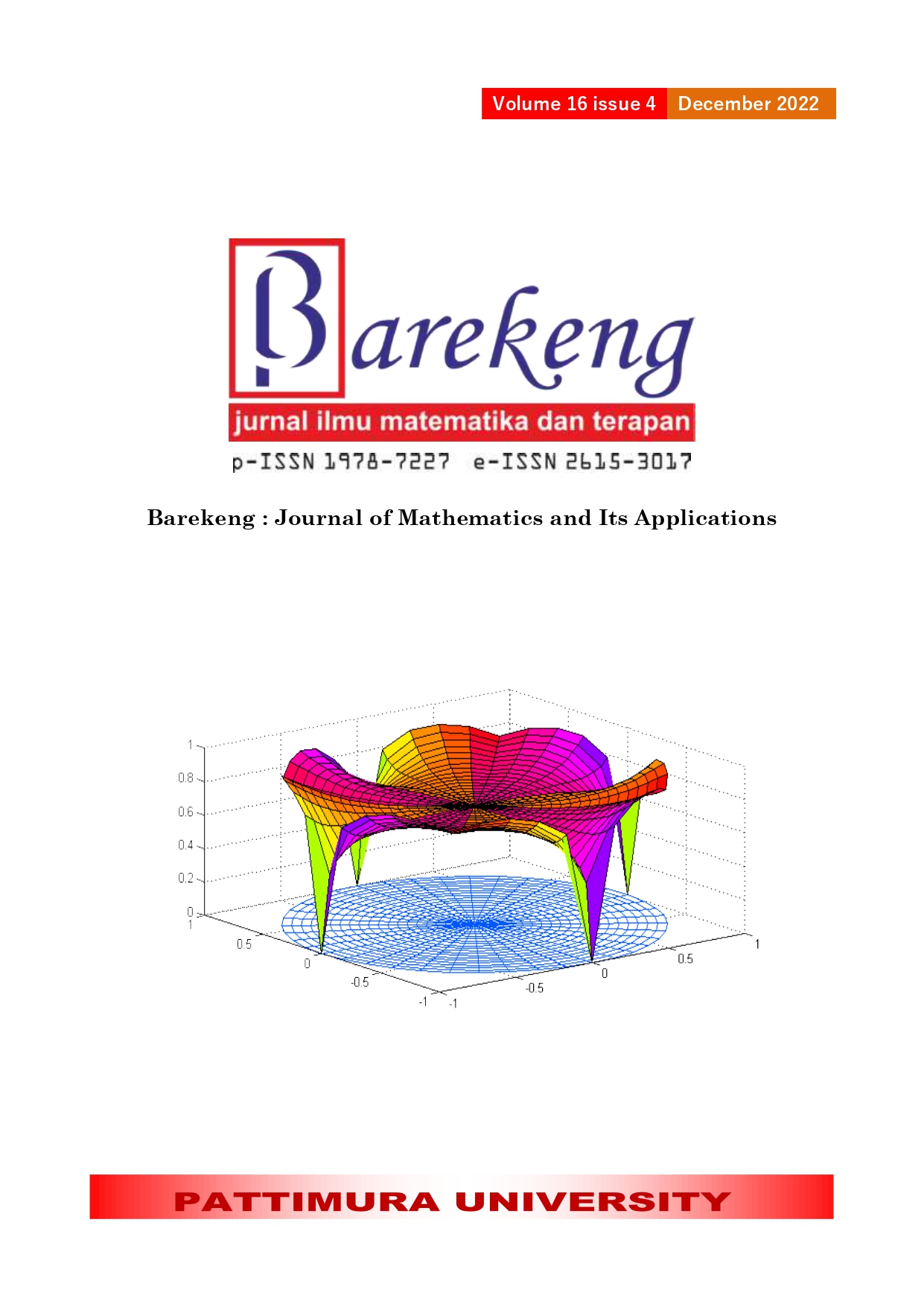THE ORDINAL LOGISTIC REGRESSION MODEL WITH SAMPLING WEIGHTS ON DATA FROM THE NATIONAL SOCIO-ECONOMIC SURVEY
Abstract
Ordinal logistic regression is a method describing the relationship between an ordered categorical response variable and one or more explanatory variables. The parameter estimation of this model uses the maximum likelihood estimation having assumption that each sample unit having an equal chance of being selected, or using simple random sampling (SRS) design. This study uses data from the National Socio-Economic Survey (SUSENAS) having two-stage one-phase sampling (not SRS). So, the parameter estimation should consider the sampling weights. This study describes the parameter estimation of the ordinal logistic regression with sampling weight using the pseudo maximum likelihood method, especially in SUSENAS sampling design framework. The variance estimation method uses Taylor linearization. This study also provides numerical examples using ordinal logistic regression with sampling weight. Data used is 121,961 elderly spread over 514 districts/cities. Testing data (20%) is used to obtain the accuracy of the prediction results. The variables used in this study are the health status of the elderly as the response variable, and nine explanatory variables. The results of this study indicate that the ordinal logistic regression model with sampling weights is more representative of the population and more capable to predict minority categories of the response variable (poor and moderate health status) than is without sampling weights.
Downloads
References
M. W. Fagerland and D. W. Hosmer, "How to test for goodness of fit in ordinal logistic regression models," Stata Journal, vol. 17, no. 3, pp. 668-686, 2017.
K. J. Archer and S. Lemeshow, "Goodness of Fit Test for a Logistic Regression Model Fitted Using Survey Sample Data," The Stata Journal, vol. 6, no. 1, pp. 97-105, 2006.
Badan Pusat Statistik, Pedoman Kepala BPS Provinsi, Kepala Bidang Statistik Sosial, dan Kepala BPS Kabupaten/Kota: SUSENAS Maret 2020, Jakarta: Badan Pusat Statistik, 2019.
M. A. Ciol, J. M. Hoffman, B. J. Dudgeon, A. Shumway-Cook, K. M. Yorkston and L. Chan, "Understanding the use of weights in the analysis of data from multistage surveys," Arch Phys Med Rehabil, vol. 87, no. 2, pp. 299-303, 2006.
S. R. Cassy, I. Natario and M. R. O. Martins, "Logistic Regression Modelling for Complex Survey Data with an Application for Bed Net Use in Mozambique," Open Journal of Statistics, vol. 6, no. 5, pp. 898-907, 2016.
K. S. Barasa and C. Muchwanju, "Incorporating Survey Weights into Binary and Multinomial Logistic Regression Models," Science Journal of Applied Mathematics and Statistics, vol. 3, no. 6, pp. 243-249, 2015.
B. Anthony, "Performing Logistic Regression on Survey Data with the New SURVEYLOGISTIC Procedure," in The Twenty-Seventh Annual SAS®Users Group International Conference, Orlando, 2002.
J. Jajang, N. Nurhayati and S. J. Mufida, "Ordinal Logistic Regression Model and Classification Tree on Ordinal Response Data," BAREKENG: J. Il. Mat. & Ter., vol. 16, no. 1, pp. 075-082, 2022.
G. Solomon and L. Weissfeld, "Pseudo maximum likelihood approach for the analysis of multivariate left-censored longitudinal data," Stat Med., vol. 36, no. 1, pp. 81-91, 2017.
A. Guolo, "Pseudo-Likelihood inference for regression models with misclassified and mismeasured variables," Statistica Sinica, vol. 21, pp. 1639-1663, 2011.
M. Abdalmoaty and H. Hjalmarsson, "Simulated Pseudo Maximum Likelihood Identification of Nonlinear Models," in The 20th IFAC World Congress, Elsevier, 2017.
G. Fiorentini and E. Sentana, "Consistent non-Gaussian pseudo maximum likelihood estimators," Journal of Econometrics, vol. 213, no. 2, pp. 321-358, 2019.
C. Gourieroux, A. Monfort and E. M. Renault, "Consistent Pseudo-Maximum Likelihood Estimators," Annals of Economics and Statistics, vol. 125/126, pp. 187-218, 2017.
J. Wang, "The Pseudo Maximum Likelihood Estimator for Quantiles of Survey Variables Get access Arrow," Journal of Survey Statistics and Methodology, vol. 9, no. 1, p. 185–201, 2021.
M. Denuit, D. Hainaut and J. Trufin, Effective Statistical Learning Methods for Actuaries I: GLMs and Extensions, Switzerland: Springer, 2019.
S. L. Lohr, Sampling: Design and Analysis, Second Edition, Boston: Brooks/Cole, 2010.
A. Demnati and J. N. K. Rao, "Linearization variance estimators for model parameters from complex survey data," Survey Methodology, vol. 36, no. 2, pp. 193-201, 2010.
F. L. Haung, "Analyzing Group Level Effects with Clustered Data Using Taylor Series Linearization," Practical Assessment, Research, and Evaluation, vol. 19, no. 1, pp. 1-9, 2014.
R. Prasetya and A. Ridwan, "Data Mining Application on Weather Prediction Using Classification Tree, Naïve Bayes and K-Nearest Neighbor Algorithm with Model Testing of Supervised Learning Probabilistic Brier Score, Confusion Matrix and ROC," Journal of Applied Communication and Information Technologies, vol. 4, no. 2, pp. 25-33, 2019.
S. Aisyah, S. Wahyuningsih and F. Amijaya, "Peramalan Jumlah Titik Panas Provinsi Kalimantan Timur Menggunakan Metode Radial Basis Function Neural Network," Jambura Journal of Probability and Statistics, vol. 2, no. 2, pp. 64-74, 2021.
United Nations Population Fund (UNFPA) and HelpAge International, "Ageing in the Twenty-First Century: A Celebration and A Challenge," UNFPA and HelpAge International, New York and London, 2012.
Copyright (c) 2022 Reni Amelia, Indahwati Indahwati, Erfiani Erfiani

This work is licensed under a Creative Commons Attribution-ShareAlike 4.0 International License.
Authors who publish with this Journal agree to the following terms:
- Author retain copyright and grant the journal right of first publication with the work simultaneously licensed under a creative commons attribution license that allow others to share the work within an acknowledgement of the work’s authorship and initial publication of this journal.
- Authors are able to enter into separate, additional contractual arrangement for the non-exclusive distribution of the journal’s published version of the work (e.g. acknowledgement of its initial publication in this journal).
- Authors are permitted and encouraged to post their work online (e.g. in institutional repositories or on their websites) prior to and during the submission process, as it can lead to productive exchanges, as well as earlier and greater citation of published works.






1.gif)



